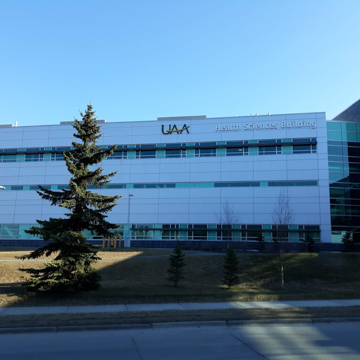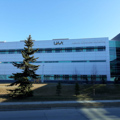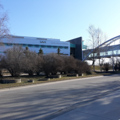The University of Alaska Anchorage’s Health Science Building (HSB) was completed in 2011 and represents the university's largest step to enhance its health-related mission. UAA is considered the health campus of the larger University of Alaska System. As the university has become more focused on health sciences, it has required the infrastructure and lab space to train students.
Although UAA does not house a medical school, the HSB contains the university’s medical, medical technology, nursing, clinical laboratory, and physician assistant programs, all of which have responded to a growing demand for healthcare professionals across the region and state. The expansion of the nursing program, in particular, has responded to a historic shortage of nurses in Alaska. The classrooms and laboratories are state-of-the-art, with new lab equipment and medical technology; the HSB is also designed to allow students and faculty to engage with medical professionals from beyond the university and takes advantage of telehealth technology to connect with faculty located outside of Alaska. The Health Sciences Building also contains simulation labs for clinical care, general hospitalization, and urgent care. In fact, the building abuts the campus of Anchorage’s Providence Hospital, the largest medical complex in the state. The parking lot, which lies immediately south of the HSB, connects the campus of the University of Alaska Anchorage to Providence Hospital. The Alaska Native Tribal Health Consortium (ANTHC) is also located in proximity to the campus. Today, the hospitals, health centers, and universities (UAA and Alaska Pacific University) compose the broader UMED (University-Medical) District of Anchorage, a primary center of economic growth and development.
The three-story, rectangular HSB has a gridded exterior defined by metal panels, stone, and glass. The entrance bay's glass curtain wall is abutted by a vertical stone slab. Steel eccentrically braced frames provide earthquake protection and also counteract movement that could affect vibration-sensitive equipment. The 65,000-square-foot building maximizes natural light as its classroom and lab space orients to the south and west. Windows also open to a view of the Chugach Mountains to the east. The HSB is connected to the university’s Engineering and Industry Building via the Parrish Bridge, which crosses Providence Drive to the northern side of the campus. Although the HSB faces Providence Road to the north, the building entrance is located to the south, adjacent to an expansive parking lot where most students, faculty, and staff arrive. The building won the 2012 IES Illumination National Award of Merit and demonstrates the commitment of the university in bolstering its College of Health and providing educated healthcare workers for the state. It was slated to be the first building in a larger expansion of health-related infrastructure at the university. However, state budget cuts and economic recessions have halted the next phase.
References
Kathleen McCoy, "UAA to celebrate grand opening of new Health Sciences Building on Oct. 7, 2011," Green and Gold, September 27, 2011 (accessed at: https://www.uaa.alaska.edu/news/archive/2011/09/uaa-to-celebrate-grand-o...)
"UAA Health Sciences Simulation Lab in Action," Alaska Public Media, November 11, 2011.

















